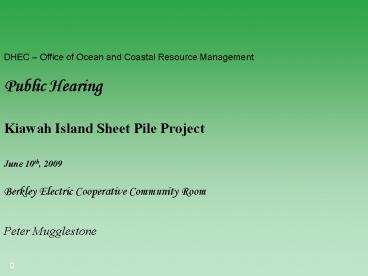Basic Information Flow - PowerPoint PPT Presentation
1 / 18
Title:
Basic Information Flow
Description:
1 Kiawah River Bend A satellite image showing the neck of the Spit ... They are known as the Navier-Stokes Equations. 7 Time dependent Fluid Mechanics 101 ... – PowerPoint PPT presentation
Number of Views:74
Avg rating:3.0/5.0
Title: Basic Information Flow
1
DHEC Office of Ocean and Coastal Resource
Management
Public Hearing
Kiawah Island Sheet Pile Project
June 10th, 2009
Berkley Electric Cooperative Community Room
Peter Mugglestone
0
2
Kiawah River Bend
A satellite image showing the neck of the Spit
and Beachwalker parking lot at the top right. The
track visible from the lower end of the lot is
used by emergency vehicles and the beach patrol
1
3
2763 Bulkhead/Revetment Proposal
An overlay showing the position of the proposed
2783 bulkhead/revetment (from submission
drawings)
2
4
2763 Bulkhead/Revetment Proposal
The position of the proposed bulkhead/revetment
3
5
Kiawah Island Sheet Pile Project
An overlay showing the position of the proposed
crane way
4
6
Kiawah Island Sheet Pile Project
Position of the proposed crane way and position
of the sheet pile bulkhead. (magenta original
submission cyan latest OCRM image)
5
7
Fluid Dynamics that apply to the Kiawah River
A brief summary of the Fluid Dynamics that apply
to the Kiawah River
5
8
Timedependent Fluid Mechanics 101
- Fluids obey Newtons 2nd Law of Motion Isaac
Newton (1687)
- The equations that describe the motion of
fluids, including those in a river bed were
developed by Claude Navier (1825) and made
practical by George Stokes (1850).They are
known as the Navier-Stokes Equations.
Philosophiæ Naturalis Principia Mathematica,
Isaac Newton (1687) Equations for an
incompressible fluid, Claude-Louis Navier
(1822)Incompressible fluids and some cases of
fluid motion, George Stokes (1842)
7
9
Navier-Stokes Equations
The top 3 equations relate acceleration, in each
of the 3 directions, to pressure gradient,
viscous forces and gravitational forces. The
final equation is continuity (fluid is not
created or destroyed)
8
10
Navier-Stokes Equations
It can be seen that each equation has terms that
relate it to the properties of the fluid in the
other two directions
- This has significant implications
- The velocity, of a small packet of fluid, depends
on the pressure and velocity of all surrounding
fluid. - The velocity of a small packet of fluid near to a
boundary, depends on that boundary and all other
boundaries.
9
11
Navier-Stokes Equations
It follows that
- The only external influences on the flow of the
fluid are due to the boundaries (the bed of the
river, the banks of the river, the surface of the
river wind, waves and wakes, the inlet and the
outlet.) - A change to any boundary will affect everything
within the influence of the fluid.
10
12
Navier-Stokes Equations
Hence, it further follows that
- A change, even a small one, to any boundary will
affect all fluid flow both upstream and
downstream.
11
13
Navier-Stokes Equations
The fluid system is unstable
- A small change to any boundary may have very
large effects on the upstream or downstream flow. - We are not able to model the boundaries
sufficiently accurately to predict the effect. - A bulkhead, revetment, change in the oyster beds,
or, spartina cover can have significant effects.
(Look at the areas around docks, or the places
where boats have been dragged over the bank into
the river)
12
14
Meanders (expected from the Navier Stokes
Equations)
The fluid (i.e. the water in the river and any
suspended material) will tend to meander. This
snake-like pattern can be seen on most rivers and
streams that do not have solid boundaries. The
mechanism of a meander is that a perfectly
straight river will be locally deflected slightly
to the side by a natural event, e.g. a tree
falling from the bank into the fluid stream. The
curvature of the flow will generate forces near
to the river bed that will tend to move particles
from the outside of the bend to the inside. This
increases the out-of-straightness of the flow and
increases the effect. The fluid will be reflected
from the opposite bank and flow in a snake-like
manner that tends to get progressively worse.
12
15
Reasonably Contained Meander
Here we see a region at the west end of Seabrook
showing recent changes to the meander pattern and
good containment of the flow field within the
banks.
It can be seen that the meander has increased
until it broke through and partially straightened
the flow. The effect will repeat (slightly
differently each cycle).
13
16
Man-made Problems
Here we see a region between the Kiawah River and
Cassique golf course, where human changes to the
system have likely caused a problem.
By changing the inlet configuration, the meander
has been modified, and the stream has shifted
closer to one bank, causing erosion.
14
17
Man-made Problems
A region of the Kiawah River basin showing the
path of the river pinned by the Kiawah Parkway
bridge. This has exaggerated the meander and
caused erosion of Mingo Point (lower right.)
Changes of the marsh, due to the bridge, are
evident.
15
18
A Classic Man-made Problem
This picture illustrates how the cut in the Spit
has exaggerated the curvature of the meander and
increased the rate of erosion at the river bend.
The original path of the river, with smaller
curvature, is clearly visible. Material has been
added to the wide end of the Spit, but there has
been more erosion at the neck.
16































